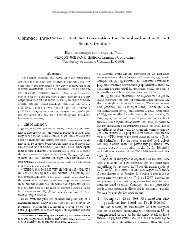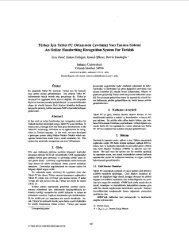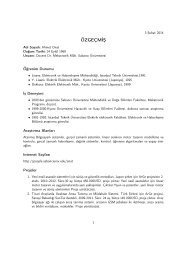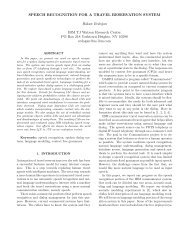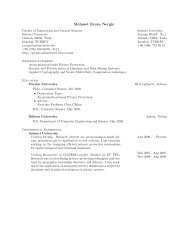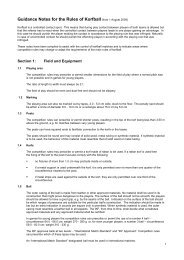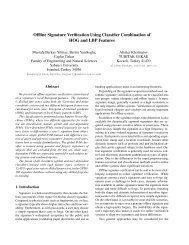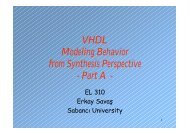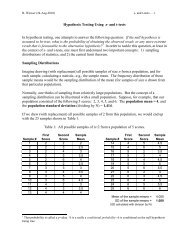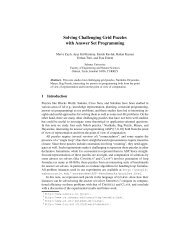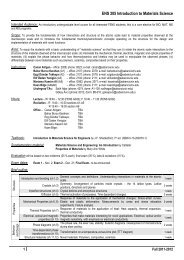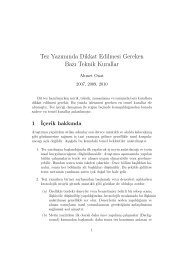Exact Distribution of Edge-Preserving MAP Estimators for Linear ...
Exact Distribution of Edge-Preserving MAP Estimators for Linear ...
Exact Distribution of Edge-Preserving MAP Estimators for Linear ...
Create successful ePaper yourself
Turn your PDF publications into a flip-book with our unique Google optimized e-Paper software.
IEEE TRANSACTIONS ON IMAGE PROCESSING, EDICS 2.3 / 1.4. REVISED 7/12/99. 1<br />
<strong>Exact</strong> <strong>Distribution</strong> <strong>of</strong> <strong>Edge</strong>-<strong>Preserving</strong> <strong>MAP</strong> <strong>Estimators</strong><br />
<strong>for</strong> <strong>Linear</strong> Signal Models with Gaussian Measurement Noise<br />
Jeffrey A. Fessler, Member, IEEE, Hakan Erdoǧan, Member, IEEE,<br />
Dept. <strong>of</strong> Electrical Engineering and Computer Science<br />
4240 EECS Bldg., University <strong>of</strong> Michigan, Ann Arbor, MI 48109-2122<br />
Email: fessler@umich.edu, Voice: 734-763-1434, FAX: 734-764-8041<br />
and Wei Biao Wu<br />
Department <strong>of</strong> Statistics<br />
1440 Mason Hall, University <strong>of</strong> Michigan, Ann Arbor, MI 48109-1027<br />
Keywords: Image reconstruction, image restoration, Bayesian methods<br />
Abstract— We derive the exact statistical distribution <strong>of</strong> maximum a<br />
posteriori (<strong>MAP</strong>) estimators having edge-preserving non-Gaussian priors.<br />
Such estimators have been widely advocated <strong>for</strong> image restoration and<br />
reconstruction problems. Previous investigations <strong>of</strong> these image recovery<br />
methods have been primarily empirical; the distribution we derive enables<br />
theoretical analysis. The signal model is linear with Gaussian measurement<br />
noise. We assume that the energy function <strong>of</strong> the prior distribution<br />
is chosen to ensure a unimodal posterior distribution (<strong>for</strong> which convexity<br />
<strong>of</strong> the energy function is sufficient), and that the energy function satisfies a<br />
uni<strong>for</strong>m Lipschitz regularity condition. The regularity conditions are sufficiently<br />
general to encompass popular priors such as the generalized Gaussian<br />
Markov random field prior and the Huber prior, even though those<br />
priors are not everywhere twice continuously differentiable.<br />
I. INTRODUCTION<br />
Many papers have described edge-preserving methods<br />
<strong>for</strong> image reconstruction and image restoration based on<br />
the Bayesian <strong>for</strong>malism with non-Gaussian priors. Recent<br />
examples in this journal include [1–4]. Maximum a<br />
posteriori (<strong>MAP</strong>) estimators <strong>for</strong> non-Gaussian priors are<br />
nonlinear and defined implicitly (lacking an explicit expression).<br />
There<strong>for</strong>e, in virtually all such papers, the evaluation<br />
<strong>of</strong> the per<strong>for</strong>mance <strong>of</strong> such methods has been investigated<br />
only empirically. This paper contributes a step<br />
towards an analytical understanding <strong>of</strong> edge-preserving<br />
<strong>MAP</strong> estimators by deriving their probability distribution<br />
functions (pdfs).<br />
We attempted to analyze the mean and covariance <strong>of</strong><br />
such implicitly defined estimators in [5] using linear approximations<br />
to the gradient <strong>of</strong> the objective function.<br />
However, non-Gaussian priors have nonquadratic energy<br />
functions that induce significant nonlinearities, rendering<br />
inaccurate the approximations in [5]. The mean and covariance<br />
analysis in [5] accommodates general measurement<br />
models. In this paper we focus on linear Gaussian<br />
measurements. Remarkably, this simple restriction allows<br />
us to derive the exact (conditional) pdf <strong>for</strong> <strong>MAP</strong> estimators<br />
having a broad class <strong>of</strong> non-Gaussian priors. This explicit<br />
<strong>for</strong>m <strong>for</strong> the pdf may be useful in analyzing the statistical<br />
properties <strong>of</strong> <strong>MAP</strong> estimation methods. The pdf may also<br />
This work was supported in part by NIH grants CA-60711 and CA-54362 and<br />
by the Whitaker Foundation.<br />
be useful <strong>for</strong> Bayesian techniques such as Gibbs sampling<br />
and Markov chain Monte Carlo, e.g. [6, 7].<br />
This paper complements the work <strong>of</strong> Abbey et al. [8,9],<br />
whodevelopedanapproximate pdf <strong>for</strong> maximum likelihood<br />
and <strong>MAP</strong> estimates under a general nonlinear signal<br />
model. (See also [10].) By considering linear signal models,<br />
we obtain the exact pdf, even <strong>for</strong> non-Gaussian priors.<br />
II. PROBLEM<br />
Let X ∈ R n denote the unknown image vector, and let<br />
Y ∈ R m denote the observed measurement vector (e.g.<br />
a noisy blurry image in image restoration, or a sinogram<br />
in image reconstruction). We assume a linear Gaussian<br />
measurement model, i.e. the conditional distribution <strong>of</strong> Y<br />
given X = x is normal:<br />
(<br />
1<br />
f(y|x) = √ exp − 1 )<br />
2π|Π| 2 (y − Ax)′ Π −1 (y − Ax) ,<br />
(1)<br />
where A is a known m×n system matrix and |Π| denotes<br />
the determinant <strong>of</strong> a known measurement noise covariance<br />
matrix Π, assumed to be symmetric positive definite. Assume<br />
that the prior distribution <strong>for</strong> X has the usual Gibbs<br />
<strong>for</strong>m:<br />
f(x) =ce −R(x) (2)<br />
where c is a constant independent <strong>of</strong> x and R(x) is an<br />
energy function that discourages image roughness. For<br />
edge-preserving image recovery, typically R(x) is a nonquadratic<br />
function [1–4], usually composed <strong>of</strong> functions<br />
that increase less rapidly than quadratic functions (see (23)<br />
below). If R(x) were quadratic, then both the prior (2) <strong>for</strong><br />
X and the measurement model (1) would be Gaussian, so<br />
the posterior distribution f(x|y) would also be Gaussian.<br />
We focus on the non-Gaussian case here, <strong>for</strong> which no explicit<br />
<strong>for</strong>m <strong>for</strong> f(x|y) has been previously found to our<br />
knowledge.<br />
Suppose we observe Y = y. Under the above assumptions,<br />
the <strong>MAP</strong> estimator ˆX <strong>for</strong> X, i.e. the maximizer <strong>of</strong>
2 IEEE TRANSACTIONS ON IMAGE PROCESSING, EDICS 2.3 / 1.4. REVISED 7/12/99.<br />
the posterior distribution f(x|y), is equivalent, by Bayes<br />
rule, to the maximizer <strong>of</strong> f(y|x)f(x), or equivalently to<br />
the minimizer <strong>of</strong> Φ(x) , − log f(y|x) − log f(x). Thus<br />
the <strong>MAP</strong> estimator <strong>for</strong> (1)-(2) minimizes the following<br />
regularized weighted least squares objective function:<br />
ˆX =argminΦ(x),<br />
x<br />
Φ(x) = 1 2 (y − Ax)′ Π −1 (y − Ax)+R(x), (3)<br />
ignoring constants independent <strong>of</strong> x, where“ ′ ” denotes<br />
matrix or vector transpose.<br />
Our goal is to characterize statistically the implicitly defined<br />
estimator ˆX = ˆX(Y ) defined in (3), even though<br />
there is no explicit expression <strong>for</strong> ˆX(·). There are two reasonable<br />
choices at this point. We could try to find the unconditional<br />
distribution f(ˆx), or find the conditional distribution<br />
f(ˆx|˜x) <strong>for</strong> some true image X =˜x <strong>of</strong> interest.<br />
One can find the <strong>for</strong>mer (in principle) from the latter by<br />
applying total probability:<br />
∫<br />
f(ˆx) = f(ˆx|˜x)f(˜x) d˜x.<br />
A devout Bayesian might focus on the unconditional distribution<br />
f(ˆx), but such a Bayesian would need to have<br />
faith that the prior distribution f(x) properly reflects the<br />
global prior characteristics <strong>of</strong> the unknown image. The<br />
fairly simple energy functions R(x) that are typically used<br />
in practice generally only capture local properties <strong>of</strong> natural<br />
images 1 . Such priors are useful <strong>for</strong> <strong>MAP</strong> estimation,<br />
but may be ill-suited <strong>for</strong> global ensemble statistics 2 . Thus,<br />
we focus on the conditional pdf f(ˆx|˜x). By studying this<br />
distribution <strong>for</strong> various true images X =˜x <strong>of</strong> interest, one<br />
could examine analytically how <strong>MAP</strong> estimates vary relative<br />
to ˜x as a function <strong>of</strong> hyperparameters, system models,<br />
noise levels, etc.<br />
III. SOLUTION<br />
Our main result is the expression <strong>for</strong> the pdf f(ˆx|˜x)<br />
given in (12) below. Our derivation is complicated by our<br />
goal <strong>of</strong> imposing minimal restrictions on the nature <strong>of</strong> the<br />
energy function R(x), so that the result is as widely applicable<br />
as possible to the cornucopia <strong>of</strong> priors that have been<br />
proposed. If we were to assume that R(x) is strictly convex<br />
and twice continuously differentiable, then the pro<strong>of</strong><br />
<strong>of</strong> the main result (12) would be fairly straight<strong>for</strong>ward.<br />
However, there are many energy functions <strong>of</strong> interest <strong>for</strong><br />
1 See [11] <strong>for</strong> an interesting exception.<br />
2 If the priors used in imaging were truly global priors, then conditional mean<br />
estimation should be more appropriate than <strong>MAP</strong> estimation under a squared<br />
error loss function.<br />
edge-preserving image recovery that do not satisfy those<br />
regularity conditions [1–4], so such a simpler pro<strong>of</strong> would<br />
be <strong>of</strong> less interest. For example, one popular prior uses<br />
an energy function <strong>for</strong>med from Huber potential functions<br />
(see e.g. [1] and (23) below) defined by<br />
{<br />
ψ Huber (t) , t 2 /2, |t| ≤δ<br />
δ|t|−δ 2 /2, |t| >δ<br />
<strong>for</strong> some user-selected parameter δ that controls the degree<br />
<strong>of</strong> edge preservation. This function is convex but<br />
not strictly convex (see Fig. 1). The derivative ψ(t) ˙ <strong>of</strong><br />
the potential function is called the influence function,and<br />
plays a key role in its edge-preserving properties and in<br />
our pdf <strong>for</strong>mula. As illustrated in Fig. 1, ˙ψ Huber (t) is not<br />
differentiable at the two points t = ±δ, i.e. ψ Huber (t) is<br />
not globally twice differentiable. Similarly, the Generalized<br />
Gaussian prior [1] has a potential function defined by<br />
ψ(t) =|t| p /2 <strong>for</strong> p ∈ (1, 2]. As illustrated in Fig. 1, this<br />
function is not twice differentiable at t =0<strong>for</strong> p
FESSLER et al.: EDGE-PRESERVING <strong>MAP</strong> DISTRIBUTION 3<br />
the following mean and covariance:<br />
µ z|˜x , A ′ Π −1 µ y|˜x (8)<br />
Π z|˜x , A ′ Π −1 A, (9)<br />
where µ y|˜x , A˜x is the conditional mean <strong>of</strong> Y given<br />
X =˜x.<br />
Equation (5) describes a functional relationship between<br />
the <strong>MAP</strong> estimate ˆX and the random vector Z having<br />
a known Gaussian pdf f(z|˜x). The problem <strong>of</strong> finding<br />
f(ˆx|˜x) thus becomes a “trans<strong>for</strong>mation <strong>of</strong> random variables”<br />
problem. The remainder <strong>of</strong> this section deals primarily<br />
with the technical aspects <strong>of</strong> showing that the trans<strong>for</strong>mation<br />
(5) leads to the pdf f(ˆx|˜x) in (12).<br />
B. General trans<strong>for</strong>mations<br />
To prove (12) under the general conditions <strong>of</strong> interest,<br />
we need the following theorem, which generalizes<br />
the usual such <strong>for</strong>mulas found in engineering probability<br />
texts.<br />
Theorem 1: (See [12,13] <strong>for</strong> pro<strong>of</strong>s.)<br />
Let g : R n → R n be one-to-one and assume that h = g −1<br />
is continuous. Assume that, on an open set V ⊆R n , h<br />
is continuously differentiable with Jacobian 3 |∇h(x)| ,<br />
∣<br />
∣det{ ∂<br />
∂x j<br />
h i (x)} ∣ .<br />
Suppose random vector Z has pdf f(z) and<br />
∫<br />
P [Z ∈ h(V c )] = f(z) dz =0, (10)<br />
V c<br />
where V c denotes the set complement (in R n )<strong>of</strong>V, and<br />
h(A) ={y ∈ R n : y = h(x), x∈A}. Then the pdf <strong>of</strong><br />
X = g(Z) is given by<br />
and is zero otherwise.<br />
|∇h(x)| f(h(x)), x ∈V, (11)<br />
C. General Case <strong>for</strong> <strong>MAP</strong> pdf<br />
Now we apply Theorem 1 to find f(ˆx|˜x). So that the<br />
problem is well defined and the analysis is tractable, we<br />
make the following assumptions.<br />
A1. A has full column rank.<br />
A2. The energy function R(x) is chosen such that, <strong>for</strong><br />
any y ∈ R m , the negative log posterior Φ has a<br />
unique stationary point that globally minimizes Φ.<br />
A3. R(x) is continuously differentiable 4 on R n .<br />
3 We use |F | to denote the absolute value <strong>of</strong> the determinant <strong>of</strong> a matrix F .<br />
4 This condition precludes the absolute value potential function (Laplacian<br />
prior).<br />
A4. R(x) is twice continuously differentiable on an<br />
open set V⊆R n .<br />
A5. The Lebesgue measure <strong>of</strong> h(V c ) is zero, where h<br />
is defined in (7).<br />
Assumptions A2-A5 are trivially satisfied by all globally<br />
twice continuously differentiable convex energy functions<br />
R(x), such as the large family described in [14]. The additional<br />
generality af<strong>for</strong>ded by these assumptions will be<br />
used in the Corollaries following the next Theorem to address<br />
energy functions that are not globally twice continuously<br />
differentiable, such as those illustrated in Fig. 1.<br />
Theorem 2: Under assumptions A1-A5 above, the conditional<br />
pdf <strong>of</strong> the (unconstrained) <strong>MAP</strong> estimator defined<br />
by (3) is<br />
f(ˆx|˜x) =<br />
∣<br />
∣∇ 2 Φ(ˆx) ∣ ∣<br />
√<br />
2π |F |<br />
exp<br />
<strong>for</strong> ˆx ∈Vand is 0 elsewhere, where<br />
( −q(ˆx;˜x) ′ F −1 q(ˆx;˜x)<br />
2<br />
)<br />
,<br />
(12)<br />
∇ 2 Φ(x) =A ′ Π −1 A + ∇ 2 R(x) (13)<br />
is the Hessian 5 <strong>of</strong> the objective function (defined on V),<br />
F , A ′ Π −1 A (14)<br />
is the Fisher in<strong>for</strong>mation matrix <strong>for</strong> estimating x under the<br />
model (1), and<br />
q(ˆx;˜x) , A ′ Π −1 A(ˆx − ˜x)+∇ ′ R(ˆx) (15)<br />
where ∇ ′ R(x) is the column gradient <strong>of</strong> R(x).<br />
Pro<strong>of</strong>:<br />
By A2 and A3, the <strong>MAP</strong> estimate (3) satisfies the trans<strong>for</strong>mation<br />
relationship given in (5). To apply (11) to (5)<br />
we must verify the conditions <strong>of</strong> Theorem 1.<br />
Ignoring constants, we can write the objective function<br />
(3) in terms <strong>of</strong> the random vector Z defined in (6):<br />
Φ(x) ≡ 1 2 x′ A ′ Π −1 Ax − x ′ Z + R(x). (16)<br />
By A2, <strong>for</strong> each Z there is a single ˆX that minimizes Φ.<br />
Thus there is an (implicit) function g : R n → R n <strong>for</strong><br />
which<br />
ˆX = g(Z) =g(A ′ Π −1 Y ). (17)<br />
We show that g is one-to-one by contradiction. Suppose<br />
there exists Z 1 ≠ Z 2 such that g(Z 1 ) = g(Z 2 ) = ˆX.<br />
Then by (5) Z 1 = h( ˆX) =Z 2 , contradicting Z 1 ≠ Z 2 .<br />
Furthermore, since g(h( ˆX)) = ˆX and h(g(Z)) = Z, h<br />
5 [∇ 2 Φ(x)] ij , ∂2<br />
∂x i ∂x j<br />
Φ(x) <strong>for</strong> x ∈V.
4 IEEE TRANSACTIONS ON IMAGE PROCESSING, EDICS 2.3 / 1.4. REVISED 7/12/99.<br />
is one-to-one with inverse g = h −1 . Although there is no<br />
explicit expression <strong>for</strong> g = h −1 in general, we can nevertheless<br />
find f(ˆx|˜x) using Theorem 1.<br />
By A3, h is continuous over R n . By A4, h is continuously<br />
differentiable over the open set V. Since the<br />
Lebesgue measure <strong>of</strong> h(V c ) is zero by A5, and since Z<br />
has a Gaussian distribution, P [Z ∈ h(V c )] is zero. Thus<br />
all the conditions <strong>of</strong> Theorem 1 are satisfied, and we can<br />
apply (11) to (5) to conclude:<br />
f(ˆx|˜x) =|∇h(ˆx)| f(z|˜x)<br />
∣ (18)<br />
z = h(ˆx)<br />
<strong>for</strong> ˆx ∈Vand is zero elsewhere. Everything on the right<br />
hand side <strong>of</strong> (18) has an explicit expression, i.e. the dependence<br />
<strong>of</strong> (17) on g = h −1 has disappeared in (18). In<br />
particular, since from (7):<br />
∇h(x) =A ′ Π −1 A + ∇ 2 R(x) =∇ 2 Φ(x) (19)<br />
<strong>for</strong> x ∈V, we arrive at the pdf expression:<br />
f(ˆx|˜x) =|∇ 2 Φ(ˆx)| f(z|˜x)<br />
∣ z = h(ˆx)<br />
(<br />
= |∇2 Φ(ˆx)| −q(ˆx;˜x) ′ Π −1<br />
z|˜x<br />
√ exp<br />
q(ˆx;˜x) )<br />
2π|Π z|˜x |<br />
2<br />
(20)<br />
<strong>for</strong> ˆx ∈V,whereΠ z|˜x is defined in (9) (cf (14)), ∇ 2 Φ(ˆx)<br />
is defined in (13), and<br />
q(ˆx;˜x) , h(ˆx) − µ z|˜x .<br />
Thus (12) is the conditional pdf <strong>of</strong> the <strong>MAP</strong> estimator. 2<br />
As a sanity check, one can consider the case <strong>of</strong> a Gaussian<br />
prior, <strong>for</strong> which the energy function is quadratic:<br />
R(x) = 1 2 x′ Rx. In this case ˆX is linear in Y ,soithas<br />
a Gaussian distribution with easily computed moments.<br />
Substituting into (12) yields the expected Gaussian distribution<br />
<strong>for</strong> ˆX.<br />
D. Practical Special Cases<br />
In principle we could leave it to the reader to verify<br />
conditions A2-A5 <strong>for</strong> her own favorite energy functions.<br />
However, establishing condition A5 is nontrivial in general<br />
<strong>for</strong> energy functions <strong>of</strong> interest such as those based<br />
on the Huber prior or Generalized Gaussian prior. In this<br />
section we provide Corollaries that show that the conditions<br />
<strong>of</strong> Theorem 2 hold under most cases <strong>of</strong> interest.<br />
We first lay some groundwork that helps cover the case<br />
<strong>of</strong> influence functions such as that <strong>of</strong> the Huber potential<br />
function shown in Fig. 1. The Huber influence function is<br />
continuous, but not differentiable. However, ˙ψ Huber does<br />
satisfy a Lipschitz condition, a property that is stronger<br />
than continuity, but weaker than differentiability. Fortunately,<br />
this weaker condition is adequate to establish conditions<br />
A4-A5.<br />
Definition 1: A function f : R n → R n is said to satisfy<br />
a uni<strong>for</strong>m Lipschitz condition (<strong>of</strong> order one) on a compact<br />
set C⊆R n if there exists a real number M C < ∞ such<br />
that<br />
‖f(u) − f(v)‖ ≤M C ‖u − v‖ , ∀u, v ∈C. (21)<br />
Define B(x, r) to be the open ball in R n <strong>of</strong> radius r centered<br />
at x ∈ R n . It follows from the Lipschitz condition<br />
(21) on f that<br />
f(B(x, r) ∩C) ⊆ B(f(x),M C r), ∀x ∈C. (22)<br />
The following Lemma will help establish A4. (See [15,<br />
p. 27, Prop. 2.2] <strong>for</strong> a closely related argument <strong>for</strong> Hausdorff<br />
measures.)<br />
Lemma 1: Let A⊂C⊂R n satisfy |A| =0,where<br />
|·| denotes Lebesgue measure, and C is a compact set. If<br />
f : R n → R n satisfies a uni<strong>for</strong>m Lipschitz condition on C,<br />
then |f(A)| =0. Thus, functions satisfying uni<strong>for</strong>m Lipschitz<br />
conditions map zero measure sets into zero measure<br />
sets.<br />
Pro<strong>of</strong>:<br />
Since A has measure zero by assumption, <strong>for</strong> any ε>0<br />
there exists a countable covering <strong>of</strong> open balls with centers<br />
∑<br />
{x i } and radii {r i } such that A⊆∪ i B(x i ,r i ) and<br />
i |B(x i,r i )|
FESSLER et al.: EDGE-PRESERVING <strong>MAP</strong> DISTRIBUTION 5<br />
and where the potential functions {ψ k } satisfy the following<br />
conditions.<br />
• Each ψ k is convex and differentiable on R (and hence<br />
continuously differentiable).<br />
• Each ψ k is twice continuously differentiable everywhere<br />
on R except possibly <strong>for</strong> a finite number n k <strong>of</strong><br />
points, say t k,1 ,...,t k,nk , where the second derivative<br />
<strong>of</strong> ψ k (t) is undefined.<br />
• Each influence function ˙ψ k satisfies a uni<strong>for</strong>m Lipschitz<br />
condition on any bounded interval [−c, c] <strong>for</strong> any<br />
c>0.<br />
Then all the conditions <strong>of</strong> Theorem 2 hold, and (12) is the<br />
conditional distribution <strong>of</strong> the <strong>MAP</strong> estimator.<br />
The preceding Corollary covers cases such as the Huber<br />
potential function, since the Huber influence function is<br />
differentiable everywhere except at t = ±δ, and satisfies<br />
a uni<strong>for</strong>m Lipschitz condition over R.<br />
However, the pro<strong>of</strong> <strong>of</strong> Corollary 1 is inapplicable to<br />
the Generalized Gaussian prior. As illustrated in Fig. 1,<br />
the Generalized Gaussian influence function is not uni<strong>for</strong>m<br />
Lipshitz over any interval <strong>of</strong> the <strong>for</strong>m [−c, c] since<br />
its derivative is unbounded near t =0<strong>for</strong> pε>0. This turns out to be adequate regularity to<br />
establish the conditions <strong>of</strong> Theorem 2, as shown by the<br />
following Corollary, proven in Appendix B.<br />
Corollary 2: Suppose A1 holds and that the energy<br />
function has the <strong>for</strong>m (23), where the potential functions<br />
{ψ k } satisfy the following conditions.<br />
• Each ψ k is convex and continuously differentiable on<br />
R.<br />
• Each ψ k (t) is twice continuously differentiable everywhere<br />
on R except possibly at t =0.<br />
• Each influence function ˙ψ k satisfies a uni<strong>for</strong>m Lipschitz<br />
condition on any bounded interval <strong>of</strong> the <strong>for</strong>m<br />
[ε, c] and [−c, −ε] <strong>for</strong> any c>ε>0. <strong>for</strong>anyε>0.<br />
Then all the conditions <strong>of</strong> Theorem 2 hold, and (12) is the<br />
conditional distribution <strong>of</strong> the <strong>MAP</strong> estimator.<br />
We note without pro<strong>of</strong> that one can combine the general<br />
approach to the pro<strong>of</strong>s <strong>of</strong> Corollary 1 and 2 to <strong>for</strong>mulate<br />
sufficient conditions <strong>for</strong> the ψ k ’s that encompass an even<br />
wider class <strong>of</strong> priors. For an energy function that has the<br />
<strong>for</strong>m (23), it is sufficient that the potential functions ψ k<br />
be convex and continuously differentiable over R, twice<br />
continuously differentiable everywhere except at a finite<br />
number <strong>of</strong> “problem” points, and that the influence functions<br />
˙ψ k be Lipschitz on closed intervals that do not contain<br />
those points. We are unaware <strong>of</strong> any differentiable<br />
convex potential functions that fail to satisfy these conditions.<br />
The pro<strong>of</strong>s <strong>of</strong> Corollary 1 and 2 do not use the fact that h<br />
is one-to-one, and only weakly use the fact that V c is a collection<br />
<strong>of</strong> hyperplanes. We conjecture that if these properties<br />
were used fully, then one could eliminate the Lipschitz<br />
conditions on the ψ k ’s and simply assume that each ψ k is<br />
convex and continuously differentiable and twice differentiable<br />
almost everywhere.<br />
IV. NON-GAUSSIAN MEASUREMENTS<br />
The above development relies fairly heavily on the assumption<br />
that Y has a Gaussian distribution, since in the<br />
Gaussian case we can easily find the pdf <strong>of</strong> Z = A ′ Π −1 Y<br />
<strong>for</strong> use in (18).<br />
When Y is non-Gaussian, (3) defines a penalized<br />
weighted least-squares (PWLS) estimator, rather than a<br />
<strong>MAP</strong> estimator. We can determine the pdf f(ˆx|˜x) <strong>of</strong><br />
this PWLS estimator even <strong>for</strong> non-Gaussian measurement<br />
noise if A is invertible (and hence square). When A is<br />
invertible, we can rewrite (4) as<br />
where<br />
Y = h 2 ( ˆX),<br />
h 2 (x) , Ax + ΠA −T ∇ ′ R(x),<br />
so similar arguments as above lead to<br />
f(ˆx|˜x) =|∇h 2 (ˆx)| f(y|x)<br />
∣ y = h2 (ˆx) . (24)<br />
Again all terms on the right hand side have explicit expressions.<br />
V. SIMPLE 2D EXAMPLE<br />
The simplest nontrivial example <strong>of</strong> (12) is when A =<br />
I 2 , Π = σ 2 I 2 ,whereI 2 is the 2 × 2 identity matrix,<br />
˜x = µ y|˜x =[0µ] ′ ,andwhere<br />
R(x) =βψ(x 1 − x 2 )<br />
<strong>for</strong> some symmetric, convex potential function ψ. One<br />
can consider this case as representing an image consisting<br />
<strong>of</strong> two neighboring pixels. If β =0, then the pixels are<br />
estimated independently by ˆx j = y j ,j=1, 2. Including<br />
a prior with energy function R(x) yields <strong>MAP</strong> estimates<br />
<strong>for</strong> the two pixel values that are encouraged to be similar.<br />
By choosing µ ≠0we can study the case where the two<br />
pixels straddle an “edge,” since their mean values differ,<br />
thereby investigating the edge-preserving properties <strong>of</strong> the<br />
prior.
6 IEEE TRANSACTIONS ON IMAGE PROCESSING, EDICS 2.3 / 1.4. REVISED 7/12/99.<br />
To compute the pdf <strong>of</strong> the <strong>MAP</strong> estimator, note that<br />
[ ]<br />
∇ ′ 1<br />
R(x) = β ˙ψ(x<br />
−1 1 − x 2 )<br />
[ ]<br />
∇ 2 1 −1<br />
R(x) = β<br />
¨ψ(x<br />
−1 1 1 − x 2 ).<br />
Thus from (13) the Hessian <strong>of</strong> Φ is<br />
[ ]<br />
∇ 2 Φ(x) = σ −2 1 −1<br />
I 2 + β<br />
¨ψ(x<br />
−1 1 1 − x 2 )<br />
[ ] ]<br />
= σ<br />
[I −2 1 −1<br />
2 + α<br />
¨ψ(x<br />
−1 1 1 − x 2 )<br />
where α , βσ 2 , and the determinant [ <strong>of</strong> that Hessian is<br />
|∇ 2 Φ(x)| = σ −4 1+2α ¨ψ(x<br />
]<br />
1 − x 2 ) .<br />
Also µ z|˜x =[0µ/σ 2 ] ′ and Π z|˜x = σ −2 I 2 . Substituting<br />
into (12) and simplifying:<br />
f(ˆx|˜x) = 1+2α ¨ψ(ˆx 1 − ˆx 2 )<br />
2πσ<br />
(<br />
2<br />
· exp − 1 ∥ [ ]<br />
[ ]∥ ) ∥∥∥ 1<br />
0 ∥∥∥<br />
2<br />
2σ 2 x + α ˙ψ(ˆx<br />
−1 1 − ˆx 2 ) − .<br />
µ<br />
As a numerical example, we computed f(ˆx|˜x) <strong>for</strong> the<br />
case σ = 0.6, µ = 1, α = 0.1. We used a generalized<br />
Gaussian energy function [1]: ψ(t) = 1 2 |t|1.5 , so the<br />
above pdf is zero on V c = {ˆx : ˆx 1 = ˆx 2 }. Fig. 2<br />
shows contours <strong>of</strong> the pdf f(ˆx|˜x). There is one mode <strong>of</strong><br />
the pdf near the true value ˜x =[01] ′ , indicated by the<br />
asterisk. Estimates that lie near this mode correspond to<br />
“preserved edges,” since the pixel estimates are closer to<br />
the truth than to each other. However, there is another<br />
mode near ˆx =[0.5 0.5] ′ , because <strong>for</strong> measurement realizations<br />
<strong>for</strong> which y 1 ≈ y 2 , the energy function <strong>of</strong> the<br />
prior encourages ˆx 1 and ˆx 2 to be approximately equal. In<br />
fact, there is a ridge <strong>of</strong> higher relative probability near the<br />
line ˆx 1 =ˆx 2 indicated by the dotted line in Fig. 2. This<br />
ridge is induced by the non-Gaussian prior; <strong>for</strong> a Gaussian<br />
prior the contours would be elliptical and centered at the<br />
conditional mean.<br />
From the contours <strong>of</strong> the exact pdf shown in Fig. 2, it<br />
would appear that simple characterizations (i.e. Gaussian<br />
approximations) <strong>of</strong> the joint pdf are nontrivial. Whether<br />
the covariance matrix <strong>of</strong> ˆX can be approximated analytically<br />
via extensions <strong>of</strong> [5] remains an open question.<br />
Fig. 3 shows the marginal distributions <strong>of</strong> f(ˆx j |˜x) computed<br />
by numerical integration <strong>of</strong> the joint pdf. Despite<br />
the complicated structure <strong>of</strong> the joint pdf, the marginal<br />
pdfs are remarkably similar to Gaussian pdfs. Thus it may<br />
be possible to find simple approximations <strong>for</strong> the marginal<br />
means and variances.<br />
VI. CONCLUSION<br />
Our main result is (12), an explicit exact expression <strong>for</strong><br />
the conditional pdf <strong>of</strong> <strong>MAP</strong> estimators <strong>for</strong> edge-preserving<br />
priors. The expression is surprisingly simple given that<br />
edge-preserving <strong>MAP</strong> estimators are defined implicitly<br />
and can be highly nonlinear. Limitations <strong>of</strong> the result include<br />
the restriction to Gaussian measurements, and the<br />
regularity assumptions <strong>for</strong> the energy function. Nevertheless,<br />
the explicit expression may prove useful in better<br />
understanding the properties <strong>of</strong> edge-preserving image<br />
recovery methods.<br />
VII. ACKNOWLEDGEMENT<br />
The authors thank C. Abbey <strong>for</strong> providing a preprint <strong>of</strong><br />
[8], <strong>for</strong> the pointer to [10], and <strong>for</strong> insightful suggestions.<br />
APPENDIX A. PROOF OF COR. 1<br />
A2 holds by the assumption that the potential functions<br />
are convex, so Φ is strictly convex. A3 holds by the assumption<br />
that the potential functions are continuously differentiable.<br />
For A4, consider V⊆R n defined by<br />
n k<br />
⋃<br />
V c , K ⋃<br />
{x ∈ R n :[Cx] k = t k,i }.<br />
k=1 i=1<br />
The set V c is a finite union <strong>of</strong> hyperplanes and thus is a<br />
closed set. There<strong>for</strong>e V is an open set on which R(x) is<br />
twice continuously differentiable, so A4 holds.<br />
To complete the pro<strong>of</strong>, we must establish A5 by showing<br />
that |h(V c )| =0,whereh was defined in (7). Because<br />
V c is a finite union <strong>of</strong> hyperplanes, |V c | =0, so we can<br />
apply Lemma 1. Define A l = V c ∩ [−l, l] n <strong>for</strong> l ∈ N.<br />
Since h(V c )=∪ ∞ l=1 h(A l), by subadditivity <strong>of</strong> Lebesgue<br />
measure |h(V c )|≤ ∑ ∞<br />
l=1 |h(A l)|, so it suffices to show<br />
that |h(A l )| =0.<br />
For the energy function R(x) given in (23) above, the<br />
function h has the <strong>for</strong>m<br />
h(x) =F x + ∇ ′ R(x) =F x +<br />
K∑<br />
c k ˙ψ k ([Cx] k ),<br />
k=1<br />
where c k denotes the transpose <strong>of</strong> the kth row <strong>of</strong> C, i.e.<br />
[Cx] k = c ′ kx. Since each ψ˙<br />
k is uni<strong>for</strong>m Lipschitz over<br />
bounded intervals, the function h is uni<strong>for</strong>m Lipschitz<br />
over [−l, l] n ,since<strong>for</strong>x ∈ [−l, l] n , |[Cx] k | ≤ c ,<br />
max k<br />
∑j |c kj| l. Thus by Lemma 1, |h(A l )| =0. 2
FESSLER et al.: EDGE-PRESERVING <strong>MAP</strong> DISTRIBUTION 7<br />
APPENDIX B. PROOF OF COR. 2<br />
Conditions A2-A4 hold as shown in the pro<strong>of</strong> <strong>of</strong> Corollary<br />
1 with the set V c in this case defined by<br />
⋃<br />
V c , K<br />
k=1<br />
H k , where H k , {x ∈ R n :[Cx] k =0} .<br />
To show A5, again define A l , V c ∩[−l, l] n , so that again<br />
it suffices to show that |h(A l )| =0, noting that |A l | =0.<br />
For any I⊆{1,...,K}, denote I c = {1,...,K}−I<br />
and define<br />
and 6<br />
G I (x) , F x + ∑ k∈I c c k ˙ψ k ([Cx] k )+ ∑ k∈I<br />
Z I = ⋂ k∈I<br />
H k .<br />
c k ˙ψ k (0)<br />
Then <strong>for</strong> x ∈Z I , clearly h(x) =G I (x).<br />
The function G I is uni<strong>for</strong>m Lipschitz on the compact<br />
set<br />
C l (I,ε) , ⋂<br />
k∈I c {x ∈ R n : |[Cx] k |≥ε}∩[−l, l] n .<br />
Thus by Lemma 1, |G I (A l ∩Z I ∩C l (I,ε))| =0<strong>for</strong> all<br />
ε>0,since|A l | =0.ButA l ∩Z I ∩C l (I,ε) ⊂Z I ,and<br />
h = G I on Z I ,so|h(A l ∩Z I ∩C l (I,ε))| =0. Defining<br />
⋃<br />
C l (I) , ∞ C l (I, 1/m),<br />
m=1<br />
then by subadditivity <strong>of</strong> Lebesgue measure,<br />
∞∑<br />
|h(A l ∩Z I ∩C l (I))|≤ |h(A l ∩Z I ∩C l (I, 1/m))|<br />
m=1<br />
which is zero. Finally, since<br />
C l (I) = ⋂<br />
k∈I c {x ∈ R n : |[Cx] k | > 0}∩[−l, l] n<br />
= ⋂<br />
H c k ∩ [−l, l]n ,<br />
k∈I c<br />
one can easily show that<br />
⋃<br />
Z I ∩C l (I) =[−l, l] n .<br />
I⊆{1,2,...,K}<br />
Thus, again by subadditivity,<br />
∑<br />
|h(A l )|≤<br />
|h(A l ∩Z I ∩C l (I))| =0.<br />
I⊆{1,2,...,K}<br />
Thus A5 holds under the conditions <strong>of</strong> the Corollary. 2<br />
6 By convention, if I = φ,then ⋂ k∈I H k = R n .<br />
REFERENCES<br />
[1] C Bouman and K Sauer, “A generalized Gaussian image model <strong>for</strong> edgepreserving<br />
<strong>MAP</strong> estimation,” IEEE Tr. Im. Proc., vol. 2, no. 3, pp. 296–<br />
310, July 1993.<br />
[2] P Charbonnier, L Blanc-Féraud, G Aubert, and M Barlaud, “Deterministic<br />
edge-preserving regularization in computed imaging,” IEEE Tr. Im. Proc.,<br />
vol. 6, no. 2, Feb. 1997.<br />
[3] A H Delaney and Y Bresler, “Globally convergent edge-preserving regularized<br />
reconstruction: an application to limited-angle tomography,” IEEE<br />
Tr. Im. Proc., vol. 7, no. 2, pp. 204–221, Feb. 1998.<br />
[4] M Nikolova, J Idier, and A Mohammad-Djafari, “Inversion <strong>of</strong> largesupport<br />
ill-posed linear operators using a piecewise Gaussian MRF,” IEEE<br />
Tr. Im. Proc., vol. 7, no. 4, pp. 571–85, Apr. 1998.<br />
[5] J A Fessler, “Mean and variance <strong>of</strong> implicitly defined biased estimators<br />
(such as penalized maximum likelihood): Applications to tomography,”<br />
IEEE Tr. Im. Proc., vol. 5, no. 3, pp. 493–506, Mar. 1996.<br />
[6] M Lavielle, “A stochastic algorithm <strong>for</strong> parametric and non-parametric<br />
estimation in the case <strong>of</strong> incomplete data,” Signal Processing, vol. 42, no.<br />
1, pp. 3–17, 1995.<br />
[7] L Bedini, E Salerno, and A Tonazzini, “<strong>Edge</strong>-preserving tomographic<br />
reconstruction from Gaussian data using a Gibbs prior and a generalized<br />
expectation-maximizationalgorithm,” Intl. J. Imaging Sys. and Tech.,vol.<br />
5, no. 3, pp. 231–8, 1994.<br />
[8] C K Abbey, E Clarkson, H H Barrett, S P Mueller, and F J Rybicki, “Approximate<br />
distributions <strong>for</strong> maximum likelihood and maximum a posteriori<br />
estimates under a Gaussian noise model,” in In<strong>for</strong>mation Processing in<br />
Medical Im., J. Duncan and G. Gindi, Eds., pp. 167–75. Springer Verlag,<br />
Berlin, 1997.<br />
[9] C K Abbey, E Clarkson, H H Barrett, S P Müller, and F J Rybicki, “A<br />
method <strong>for</strong> approximating the density <strong>of</strong> maximum likelihood and maximum<br />
a posteriori estimates under a Gaussian noise model,” Med. Im.<br />
Anal., vol. 2, no. 4, pp. 395–403, 1998.<br />
[10] O E Barndorff-Nielsen, “On a <strong>for</strong>mula <strong>for</strong> the distribution <strong>of</strong> the<br />
maximum-likelihood estimator,” Biometrika, vol. 70, no. 2, pp. 343–65,<br />
1983.<br />
[11] V E Johnson, “A model <strong>for</strong> segmentation and analysis <strong>of</strong> noisy images,”<br />
J. Am. Stat. Ass., vol. 89, no. 425, pp. 230–241, Mar. 1994.<br />
[12] P J Bickel and K A Doksum, Mathematical statistics, Holden-Day, Oakland,<br />
CA, 1977.<br />
[13] J A Fessler, “On trans<strong>for</strong>mations <strong>of</strong> random vectors,” Tech. Rep.<br />
314, Comm. and Sign. Proc. Lab., Dept. <strong>of</strong> EECS, Univ. <strong>of</strong> Michigan,<br />
Ann Arbor, MI, 48109-2122, Aug. 1998, Available from<br />
http://www.eecs.umich.edu/∼fessler.<br />
[14] K Lange, “Convergence <strong>of</strong> EM image reconstruction algorithms with<br />
Gibbs smoothing,” IEEE Tr. Med. Im., vol. 9, no. 4, pp. 439–446, Dec.<br />
1990, Corrections, T-MI, 10:2(288), June 1991.<br />
[15] K J Falconer, Fractal geometry: mathematical foundations and applications,<br />
Wiley, New York, 1990.<br />
Jeffrey A. Fessler Jeff Fessler received the BSEE<br />
degree from Purdue University in 1985, the MSEE<br />
degree from Stan<strong>for</strong>d University in 1986, and the<br />
M.S. degree in Statistics from Stan<strong>for</strong>d University in<br />
1989. From 1985 to 1988 he was a National Science<br />
Foundation Graduate Fellow at Stan<strong>for</strong>d, where<br />
he earned a Ph.D. in electrical engineering in 1990.<br />
He has worked at the University <strong>of</strong> Michigan since<br />
then. From 1991 to 1992 he was a Department <strong>of</strong> Energy<br />
Alexander Hollaender Post-Doctoral Fellow in<br />
the Division <strong>of</strong> Nuclear Medicine. From 1993 to 1995<br />
he was an Assistant Pr<strong>of</strong>essor in Nuclear Medicine and the Bioengineering Program.<br />
Since 1995 he has been with the Department <strong>of</strong> Electrical Engineering<br />
and Computer Science, where he is an Associate Pr<strong>of</strong>essor. His research interests<br />
are in statistical aspects <strong>of</strong> imaging problems.
8 IEEE TRANSACTIONS ON IMAGE PROCESSING, EDICS 2.3 / 1.4. REVISED 7/12/99.<br />
recognition.<br />
Hakan Erdoğan Hakan Erdoğanreceivedthe B.S. degree<br />
in Electrical Engineering and Mathematics from<br />
Middle East Technical University, Ankara in 1993,<br />
the M.S. and Ph.D. degree in Electrical Engineering:<br />
Systems from the University <strong>of</strong> Michigan in 1995 and<br />
1999 respectively. He worked as a research assistant<br />
at the University <strong>of</strong> Michigan on the area <strong>of</strong> statistical<br />
image reconstruction methods <strong>for</strong> transmission and<br />
emission tomography. Dr. Erdogan joined IBM T.J.<br />
Watson Research Labs in 1999. His research interests<br />
are tomographicimage reconstruction and speech<br />
2.5<br />
2<br />
1.5<br />
Contours <strong>of</strong> pdf <strong>of</strong> <strong>MAP</strong> estimator, µ=1 σ=0.6 α=0.1 δ=1.5<br />
Wei Biao Wu Wei Biao Wu received MS from University<br />
<strong>of</strong> Michigan in 1999 and currently is a Ph.D.<br />
candidate in Department <strong>of</strong> Statistics. His research<br />
interests are random dynamical systems, bootstrap,<br />
Markov chains and martingales, and limit theorems<br />
in probability theory.<br />
ˆx2<br />
1<br />
0.5<br />
0<br />
−0.5<br />
−1.5 −1 −0.5 0 0.5 1 1.5<br />
ˆx 1<br />
Fig. 2. Contours <strong>of</strong> conditional pdf (12) <strong>of</strong> <strong>MAP</strong> estimator with generalized<br />
Gaussian prior. There is one mode near the true parameter ˜x =[01] ′ ,and<br />
a second mode near the average parameter ˆx =[0.50.5] ′ .<br />
0.8<br />
<strong>Exact</strong> (−) and Gaussian fit (−−)<br />
ψ(t)<br />
ψ(t)<br />
1.5<br />
1<br />
0.5<br />
Huber Potential δ=1<br />
0<br />
−2 −1 0 1 2<br />
t<br />
1.5<br />
1<br />
0.5<br />
Generalized Gauss. Potential p=1.5<br />
0<br />
−2 −1 0 1 2<br />
t<br />
d/dt ψ(t)<br />
d/dt ψ(t)<br />
Huber Influence Function<br />
1<br />
0.5<br />
0<br />
−0.5<br />
−1<br />
−2 −1 0 1 2<br />
t<br />
Gen. Gauss. Influence Func.<br />
1<br />
0.5<br />
0<br />
−0.5<br />
−1<br />
−2 −1 0 1 2<br />
t<br />
f(ˆx1|˜x)<br />
f(ˆx2|˜x)<br />
0.6<br />
0.4<br />
0.2<br />
0<br />
−3 −2 −1 0 1 2 3<br />
0.7<br />
0.6<br />
0.5<br />
0.4<br />
0.3<br />
0.2<br />
0.1<br />
<strong>Exact</strong> and Gaussian fit<br />
0<br />
−3 −2 −1 0 1 2 3<br />
Fig. 3. Marginal conditional pdfs <strong>of</strong> the components <strong>of</strong> the <strong>MAP</strong> estimator,<br />
computed numerically from the joint pdf shown in Fig. 2. These marginal<br />
pdfs are surprisingly Gaussian, despite the highly non-Gaussian joint pdf.<br />
ˆx 1<br />
ˆx 2<br />
Fig. 1. Huber and Generalized Gaussian potential functions ψ(t), and derivatives<br />
˙ψ(t).



